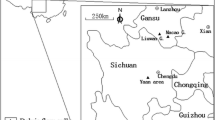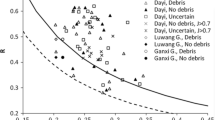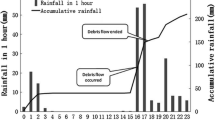Abstract
Many debris flows were triggered within and also outside the Dayi area of the Guizhou Province, China, during a rainstorm in 2011. High-intensity short-duration rainfall was the main triggering factor for these gully-type debris flows which are probably triggered by a runoff-induced mechanism. A revised prediction model was introduced for this kind of gully-type debris flows with factors related to topography, geology, and hydrology (rainfall) and applied to the Wangmo River catchment. Regarding the geological factor, the “soft lithology” and “loose sediments” in the channel were added to the list of the average firmness coefficient for the lithology. Also, the chemical weathering was taken into account for the revised geological factor. Concerning the hydrological factor, a coefficient of variation of rainfall was introduced for the normalization of the rainfall factor. The prediction model for debris flows proposed in this paper delivered three classes of the probability of debris flow occurrence. The model was successfully validated in debris flow gullies with the same initiation mechanism in other areas of southwest China. The generic character of the model is explained by the fact that its factors are partly based on the initiation mechanisms and not only on the statistical analyses of a unique variety of local factors. The research provides a new way to predict the occurrence of debris flows initiated by a runoff-induced mechanism.







Similar content being viewed by others
References
Cannon SH, Gartner JE, Rupert MG, Michael JA, Rea AH, Parrett C (2010) Predicting the probability and volume of postwildfire debris flows in the intermountain western United States. Geol Soc Am Bull 122(1–2):127–144
Chang TC (2007) Risk degree of debris flow applying neural networks. Nat Hazards 42:209–224
Fookes PG, Dearman WR, Franklin JA (1971) Some engineering aspects of rock weathering with field examples from dartmoor and elsewhere. Q J Eng Geol 4(3):161–163
Han L, Yu B, Lu K (2011) Relationship of frequency of debris flows and the particle size in the channel. Res Environ Yangtze Basin 20:1149–1156 (in Chinese with English abstract)
Hu K, Cui P, Ma C, Zhou G, Tian M (2012) Causes and characteristics of 28 June disastrous debris flow event in Ningnan County of Sichuan, China. J Mt Sci 30(6):696–700 (in Chinese with English abstract)
Johnson AM, Rodine JR (1984) Debris flow. In: Brunsden D, Prior DB (eds) Slope instability. Wiley, Chichester, UK, pp 257–361
Kean JW, Staley DM, Cannon SH (2011) In situ measurements of post-fire debris flows in southern California: comparisons of the timing and magnitude of 24 debris-flow events with rainfall and soil moisture conditions. J Geophys Res 116:F04019. doi:10.1029/2011JF002005
Kean JW, McCoy SW, Tucker GE, Staley DM, Coe JA (2013) Runoff-generated debris flows: observations and modeling of surge initiation, magnitude, and frequency. J Geophys Res Earth Surf 118:2190–2207
LIGC and TSIG (Lanzhou Institute of Glaciology and Cryopedology, and Traffic Science Institute of Gansu Province, China) (1982) Debris flow in Gansu Province. People’s Transportation Press, Beijing, pp 125–156
Liu C, Dong J, Peng Y, Huang H (2009) Effects of strong ground motion on the susceptibility of gully type debris flows. Eng Geol 104(3–4):241–253
Ma D, Qi L (1997) Study on comprehensive controlling of debris flow hazard in Sanyanyu Gully. Bull Soil Water Conserv 17(4):26–31 (in Chinese with English abstract)
Ma S, Zhang X (1991) Some rules of variation coefficient of annual rainfall in Xinjiang. ACTA Meteorol SINICA 49(1):39–45 (in Chinese with English abstract)
NSBC (National Seism Bureau of China) (1990) Seismic distribution map of China. Beijing, Seism Press. (in Chinese)
Protodyakonov MM (1962) Mechanical properties and drillability of rocks. In: Proceedings of the fifth symposium on rock mechanics. Minneapolis, MN, University of Minnesota, pp 103–118
Shieh CL, Chen YS, Tsai YJ (2009) Variability in rainfall threshold for debris flow after the Chi–Chi earthquake in central Taiwan, China. Int J Sedim Res 24:177–188
Su P, Wei F, Gu L, Ni H (2010) Characteristic and causes of group-occurring debris flow in Dechang County, Sichuan Province. J Mt Sci 28(5):593–606 (in Chinese with English abstract)
Takahashi T (2000) Initiation and flow of various types of debris flow. In: Wieczorek GF, Naeser ND (eds) Debris-flows hazard mitigation: mechanics, prediction, and assessment balkema. Rotterdam, Netherlands, pp 15–25
Tan W, Han Q (1992) Research on the critical rainfall of debris flows in Sichuan Province, China. Hazards 7(2):37–42 (in Chinese with English abstract)
Tan W, Yang Z (1984) “791102” debris flows of Yaan and analysis of torrential rain genesis. Debris Flow (No.3). Chongqin: Chongqin division of Science and Technique Press, pp 9–14 (in Chinese with English abstract)
Wu J, Kang Z, Tian L, Zhang S (1990) Observation and research on the debris flows in Jiangjia Gully, Yunnan Province, China. Science Press, Beijing, pp 197–221
Xu Q (2010) The 13 August 2010 catastrophic debris flow in Sichuan Province: characteristics, genetic mechanism and suggestions. J Eng Geol 18:596–608 (in Chinese with English abstract)
Xu Q, Zhang S, Li L, van Asch ThWJ (2012) The 13 August 2010 catastrophic debris flows after the 2008. Nat Hazards Earth Syst Sci 12:201–216
Yang F, Liu X, Yang K, Cao S (2009) Study on the angle of repose of nonuniform sediment. J Hydrodyn 21:685–691
Yu B, Yang Y, Su Y, Huang W, Wang G (2010) Research on the giant debris flow hazards in Zhouqu County, Gansu Province on August 7, 2010. J Eng Geol 18:437–444 (in Chinese with English abstract)
Yu B, Li L, Ma Y, Zhang J, Wu Y, Zhang H, Chu S, Qi X (2011) Research on topographical factors in the formation of gully type debris flows. River, coastal and estuarine morphodynamics: RCEM2011, Tsinghua University Press, Beijing, pp 1–10
Yu B, Chu S, Lu K, Han L, Xie H (2012) A study about the relationship between the frequency of debris flows and lithology. In: Eberhardt et al (ed) Landslides and engineered slopes: protecting society through, improved understanding, pp 757–761
Yu B, Chu S, Zhu Y, Xie H (2013a) Impacts of weathering on formation of gullied debris flow. Bull Soil Water Conserv 33:51–56 (in Chinese with English abstract)
Yu B, Li L, Wu Y, Chu S (2013b) A formation model for debris flows in the Chenyulan River Watershed, Taiwan. Nat Hazards 68:745–762
Yu B, Ma Y, Wu Y (2013c) Case study of a giant debris flow in the Wenjia Gully, Sichuan Province, China. Nat Hazards 65:835–849
Zhang X., Liu J (1989) Debris flows in the basin of Dayinjaing, Yunnan, China. Chengdu, Map Press of Chengdu, pp 1–64. (in Chinese)
Acknowledgments
This work was supported by the National Natural Science Foundation of China (NSFC, contract number: 41372366) and the State Key Laboratory of Geohazard Prevention and Geoenvironment Protection Foundation (contract number: SKLGP2012Z011). We thank the reviewers for their comments that helped us to greatly improve the presentation of this work. We are grateful to Dr. Theo van Asch for having provided a very helpful review of the manuscript, and for help on the English editing of the manuscript.
Author information
Authors and Affiliations
Corresponding author
Rights and permissions
About this article
Cite this article
Yu, B., Zhu, Y., Wang, T. et al. A prediction model for debris flows triggered by a runoff-induced mechanism. Nat Hazards 74, 1141–1161 (2014). https://doi.org/10.1007/s11069-014-1234-0
Received:
Accepted:
Published:
Issue Date:
DOI: https://doi.org/10.1007/s11069-014-1234-0




